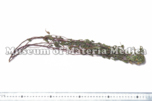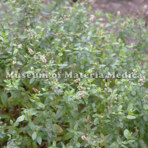Mentha Herb

|
Market name:ハッカ Photo location:Museum of Materia Medica, Inst. of Nat. Med. TMPW No.:9844 |

|
Plant name:Mentha piperita Photo location:Kyoto Pref., Japan Photo date:1990 Photographer:K. Komatsu |
| Synonym | |
| Latin name | Menthae Herba |
| Botanical source: Family name | Labiatae |
| Botanical source: Plant name | Mentha arvensis var. piperascens Malinvaud |
| Part used | Terrestrial part |
| Empirical criteria for quality selection | The leaf of good one is dark-green and has a strong odor (TN). |
| Constituents | Monoterpenoids: l-Menthol (70-90% of essential oil), l-Menthone, 1,8-Cineole, Isomenthone, d-Neomenthol, α-Pinene, Camphene, Menthenone, l-Limonene, Piperitone, Piperitenone, Pulegone Sesquiterpenoids: β-Caryophyllene, Germacrene-D |
| Pharmacological effects | Central inhibition, vasodilation, skin stimulation, spasmolysis (essential oil), local stimulation, local anesthesia, spasmolysis, carminative, cholagogue, and anthelmin (menthol). |
| Indications | As an aromatic stomachic and carminative, it is applied to treat headache, dizziness, sore throat, scrofula and a discomfort feeling of distension in the chest and abdomen. Mostly, it is used as raw material for l-menthol (antiseptic, local anesthesia), peppermint oil and peppermint water. |
| Diseases | Fever, Chill, Headache, Anhidrosis, Swelling and pain of the throat, Red eye, Measles, Itching, Pain due to flatulence of hypochondrium, Full stomach, Abdominal pain, Vomitting, Diarrhea |
| Formulas | kagenryokakusan (asada) , kagenryokakusan (kyoteiken) , kamishoyosan , kamishoyosankasenkyujio , kyoseihatekigan , keigairengyoto , keibohaidokusan , saikoseikanto , shoyosan , jiinshihoto , seijobofuto , senkanmeimokuto , senkyuchachosan , bofutsushosan , ryokakusan |
| Meridian tropism | Lung, Liver |
| Property | Cool |
| Flavor | Acrid/pungent |
| Classification in "Shen-non Ben-cao Jing" | |
| TCM: Classification | Diaphoretics |
| TCM: Medicinal effects | To dispel wind-heat from the head and eyes, and to quench eruption. Used for headache in influenza, upper respiratory infection and other epidemic febrile disease at the initial stage, inflammation of eye, sore throat, ulcers in the mouth, rubella and measles, discomfort with the feeling of distension in the chest and hypochondriac regions. |
| Remarks | Listed in the Japanese Pharmacopoeia 18th ed. |
| References | TN: T. Namba & Y. Tsuda ed., Outline of Pharmacognosy, a Textbook, 3rd ed., Nankodo Co., Ltd., Tokyo, 1998. |
DNA sequences of medicinal plants
| Gene Region | |||||||||||||||||||
| Nuclear | Chloroplast | Mitochondria | |||||||||||||||||
| Botanical source: Plant name | 5Ss | 18S | ITS1 | 5.8S | ITS2 | 26S | others | trnH-psbA | matK | trnK | trnK-rps16 | trnT-L | trnL | trnL-F | rbcL | rpoC1 | ndhF | others | |
|
|
|||||||||||||||||||
